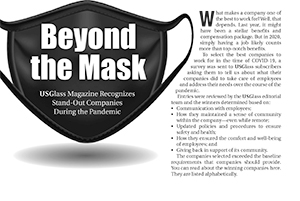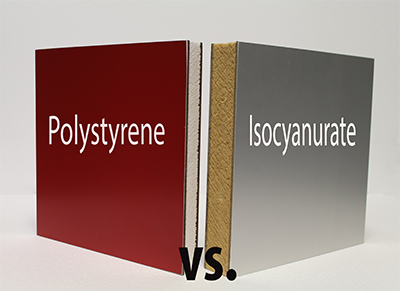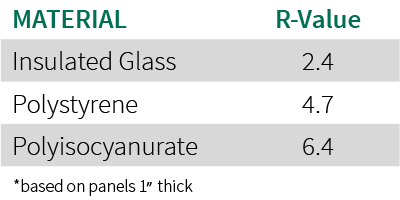Mapes Panels Receives National Recognition by USGlass Magazine

Polystyrene vs. Polyisocyanurate
The primary difference between the 2 core materials is the insulating value (or R-Value). Polystyrene has a typical R-value of approximately 4.4 per 1″ thickness of material. Polyisocyanurate’s typical R-value for the same 1″ of material is approximately 6.0.
When laminated into a 1″ thick panel with standard 1/8″ substrates and aluminum skins, the polystyrene panel yields a total R-value of approximately 4.7 while the Polyisocyanurate panel will achieve an R-value of 6.4. In comparison, a typical 1″ insulated glass unit offers an approximate R-value of 2.4.
So if you’re looking for the most economical core material, choose Polystyrene. If you need more insulating value, you’ll want Polyisocyanurate. As previously mentioned, either core will give you a quality product.


IMPs Improve Overall Building Aesthetics and Thermal Performance
Reproduced with permission from METAL CONSTRUCTION NEWS June 2015
An integral part of commercial building projects
Laminated insulated metal panels, particularly those for use as infill in curtainwall, storefront and window system glazing, have been an integral part of commercial building projects for the better part of the last century. However, despite their wide use in an incredible variety of applications, they are often considered an afterthought.
And why not? The word “infill” itself seems to imply that something should just be thrown in the opening to fill it in.
This is a thought process that minimizes the impact these panels can have on the overall aesthetics and thermal performance of a commercial building.
What Are They?
Insulated infill panels typically consist of an interior and exterior skin (aluminum or steel) laminated to any variety of substrates. These substrates/skins then sandwich an insulating core to give you a 5-ply panel ready to be glazed into the frame. The most commonly used substrate is tempered hardboard, which has been considered an industry standard for more than 50 years.
However, over the last 20 years, there has been a rise in other substrate materials. These include, but are not limited to:
- Fiber Reinforced Cement Board (which is a Class A, non-combustible material)
- Corelite (or corrugated plastic, a lightweight material that offers a higher level of moisture resistance)
- Gypsum Board (which is used to meet fire codes when used as the interior substrate)
- And most recently, solid plastic (or ABS board).
The solid plastic is particularly exciting as it offers the moisture resistance of Corelite, the impact resistance of cement board and the rigidity of tempered hardboard without sacrifice.
Aesthetics Please…
One of the primary benefits of using infill panels is that they are customizable to suit the aesthetic needs of nearly any application. Need the face of the panels to match the color of the framing system? Or do you need units that will act as accent panels? No problem! Reputable panel manufacturers can supply customized units with anodized aluminum, high-performance PVDF (Kynar), or cost-effective baked enamel skins to fit almost any need or budget.
Kynar skins are particularly versatile as they are available in almost every color under the sun.
The Value is in the R-Value
The most valuable contribution of insulated infill panels is the boost in R-value you get versus using traditional spandrel glass or insulated glass units (IGUs). Assuming a 1-inch panel, the minimum R-value you will get will be R–4.7. This value assumes the use of cost-effective 2# density polystyrene as the insulating material. Even the more advanced argon-filled IGUs carry values closer to R-4.
Upgrading the insulating core to 2# density isocyanurate (modified urethane) instead of the polystyrene yields a value closer to R–6.4. As impressive as this is, it doesn’t begin the scratch the surface on the R-values you can get from insulated infill panels.
Panels now offer the R-value you would get from a much thicker unit without major modification to the pocket in which the panel will be installed. This is accomplished by rabbeting the edges of a thicker panel to accommodate any existing glazing pocket, allowing the additional insulation to extend deeper into the framing system. Values as high as R-27 are now achievable using glazing pockets as narrow as 1/4-inch.
Making an Impact
Others will meet impact- and blast-resistance criteria for use in hurricane-prone or high-security areas. Bullet-resistant panels are also an option. Infill panels are also available with 1/4-inch spandrel glass on the exterior to match the look of the glass on the rest of your project.
On formed-edge panels, the exterior face of the panels can now be custom fabricated to offer a clean look where the face of the panel is flush with the face of the framing system. Use of Class A materials or gypsum board can give you a panel that meets local fire codes.
Lincoln, Neb.-based Mapes Panels takes a great deal of pride in being able to custom design/build a panel that will meet or exceed the performance criteria for your project. Insulated infill panels offer unlimited design possibilities and can enhance both the aesthetics and performance of any commercial building.
Mapes-R+ Rabbet Edge Panels
Mapes-R+ Rabbet Edge Panels easily fit into any standard glazing pocket and can improve potential R-Value by up to 300%, making the Mapes-R+ panels a smart addition to your next project. They are available in any of our finishes, including custom colors, and can be designed to suit your application.

